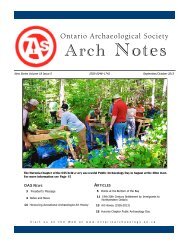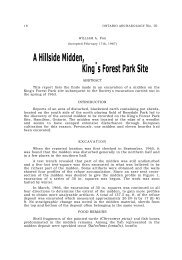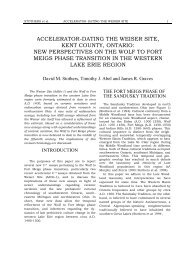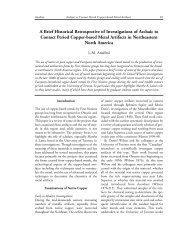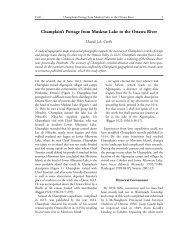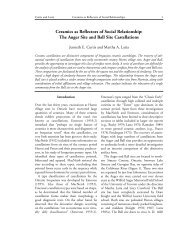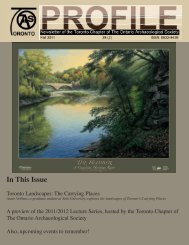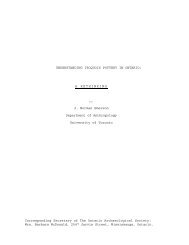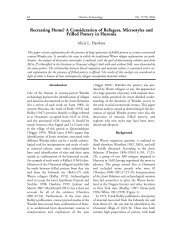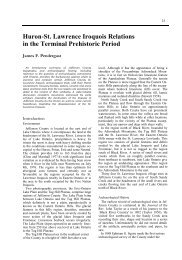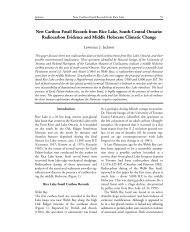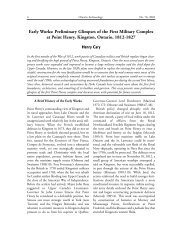The Little Ice Age and Neutral Faunal Assemblages - Ontario ...
The Little Ice Age and Neutral Faunal Assemblages - Ontario ...
The Little Ice Age and Neutral Faunal Assemblages - Ontario ...
You also want an ePaper? Increase the reach of your titles
YUMPU automatically turns print PDFs into web optimized ePapers that Google loves.
CAMPBELL & CAMPBELL: LITTLE ICE AGE 15FIGURE 2Pollen diagrams of selected taxa from Crawford Lake, Marion Lake, <strong>and</strong> Gignac Lake. Redrawn fromMcAndrews (1988), Bernabo (1981), <strong>and</strong> Burden et al. (1985)
16 ONTARIO ARCHAEOLOGY NO.49FIGURE 3Calibrated pollen climate transfer curve for Michigan. Redrawn from Bernabo (1981).nabo, 1981), <strong>and</strong> Gignac Lake, <strong>Ontario</strong> (Burden etal., 1986) are sufficiently detailed to show smallclimatic fluctuations over the last 1,000 years (Fig.2). McAndrews <strong>and</strong> Boyko-Diakonow (in press)analyzed annually laminated sediments from CrawfordLake, in southern <strong>Ontario</strong>. <strong>The</strong> resulting recordextends back to AD 1000, at which time the pollenrecord is dominated by beech, maple, elm, oak <strong>and</strong>birch (Fig. 2). Hemlock is also common but itspaleoclimatic significance is unclear at this time.This mixed hardwood forest yields to a mixedpine-oak-birch forest ca AD 1400, a change whichMcAndrews <strong>and</strong> Boyko-Diakonow attribute in partto Indian clearing of the forest <strong>and</strong> to old fieldsuccession. After AD 1850, this forest in turn yieldsto European agricultural fields, which show up inthe diagram as a dramatic increase in grass <strong>and</strong>ragweed, <strong>and</strong> a decrease in oak <strong>and</strong> pine. However,beech is already in decline by AD 1200, well beforethe first appearance of maize pollen at CrawfordLake in AD 1360. This cannot be explained by theeffects of local Indian horticulture, as no other taxashow an appreciable decline at this time <strong>and</strong> herbpollen does not rise. Very large portions of thesurrounding region would have to have been affectedby man for pollen transport from long distancesto account for the changes in relativeimportance of the tree taxa. Of the five dominanttree types in the pre-1400 portion of the diagram,beech has the most southerly northern distributionlimit. It would therefore be expected to react firstto even a slight cooling of the climate. <strong>The</strong>re is littledoubt that the suddenness of the increase in oak <strong>and</strong>pine following the arrival of maize is due to forestclearance <strong>and</strong> field ab<strong>and</strong>onment (McAndrews <strong>and</strong>Boyko-Diakonow, in press). However, the failureof the forest to return to its previous beechdominatedassemblage following field ab<strong>and</strong>onmentmay be due either to ecological inertia or to aclimatic deterioration which occurred in the interim(McAndrews, 1988).<strong>The</strong> Gignac Lake diagram (Fig. 2) from AwendaProvincial Park, on the south shore of GeorgianBay, also shows the effect of Indian horticulture(Burden et al., 1986). Maize pollen appears in smallquantities in subzone 3d (the same zonation is usedin McAndrews <strong>and</strong> Boyko-Diakonow, in press).However, as with Crawford Lake, beech begins itsdecline prior to the subzone 3c/3d transition, whichrepresents the onset of local Indian horticulture.Bernabo (1981) does not discuss the possibleeffects of Indian horticulture in Michigan, but doesnote that "beech pollen undergoes a protracteddecline at each site from AD 1200 to 1600, generallyhitting its lowest levels about AD 1450" (Bernabo,1981). He further develops a calibrated pollenclimatetransfer function, <strong>and</strong> applies it to the fossilpollen data from the Marion, Heart, Jones <strong>and</strong>Twenty-seven Lakes sites (Fig. 3). <strong>The</strong> resultingpalaeotemperature curves are partially validated byinstrumental records from the early 1800s, <strong>and</strong> alsoby correlation with worldwide
CAMPBELL & CAMPBELL: LITTLE ICE AGE 17FIGURE 4Number of <strong>Neutral</strong> sites with faunal analyses plotted through time.records of proxy data such as oxygen Isotope curvesfrom glacier ice-cores on Devon Isl<strong>and</strong>, <strong>and</strong> treeringdata from California. He concludes that "aprotracted <strong>Little</strong> <strong>Ice</strong> <strong>Age</strong> cooling took place after caAD 1200 <strong>and</strong> growing season temperatures reached1°C below the 1931-1960 mean in the 1700s." <strong>The</strong>correlation with other sites around the worldsuggests that the LIA was an essentiallysynchronous global phenomenon.Gajewski (1987) uses statistical methods to interpretthe palynology of seven lakes across the northeasternUnited States. He finds that a warm periodoccurred between AD 1000 <strong>and</strong> 1200, <strong>and</strong> a coolerperiod from AD 1450 to 1850, corresponding withLamb's (1977) dates for the LIA. For purposes ofour paper, the dates ca. AD 1450-1850 have beenadopted for the LIA; however, time lags in responseto changing conditions may have varied dependingon individual circumstances of site locations.Several authors use different dates for the LIA; this isto be expected since the change was gradual ratherthan abrupt.<strong>Neutral</strong> HorticultureDespite the growing number of plant macrofossilanalyses in <strong>Ontario</strong> (Crawford, 1987; Fecteau,1985; Ounjan, in prep.), the available data are noteasy to interpret beyond simply noting the presenceor absence of particular species. <strong>The</strong>re is little doubtthat corn, beans, <strong>and</strong> other cultigens were abundantafter at least AD 1350; the question is how importantwere they to the <strong>Neutral</strong> diet. It is difficult todetermine this from plant macrofossil data alone, asa change in the relative importance of horticulturalproduce need not affect the ratios in which thevarious crops were produced. <strong>The</strong> increase in thenumber of horticultural village sites through time(Fecteau 1985) suggests either an increased relianceon horticulture or, more likely, a populationincrease among horticulturalists. A correspondingincrease in the number of sites which have beenanalyzed for faunal material can be seen in the datapresented in this paper (Fig. 4).In the absence of any direct palaeoethnobotanicalindication of change in <strong>Neutral</strong> plant use over time,
CAMPBELL & CAMPBELL: LITTLE ICE AGE 19FIGURE 5Present Northern limits of effective Indian horticulture. Numbers refer to sites shown in Fig. 1.FORESTMoose, snowshoe hare, wolf, marten, fox, felids, black bear, skunk, chipmunk,cervids, porcupineFIELDEastern Cottontail, woodchuck, grey squirrel, mouse, short-tailed weaselTABLE 1Habitats of selected mammalian species. Based on Burt (1972) <strong>and</strong> Whitaker (1980). Grey squirrel has beenincluded in the field group due to its habit of feeding in corn fields.
CAMPBELL & CAMPBELL: LITTLE ICE AGE 21FIGURE 7Variation in the percentages of Northern <strong>and</strong> Southern taxafollow a strictly linear relationship with time, <strong>and</strong>other factors affect faunal percentages includingsite location, site use, warfare, recovery bias, etc.<strong>The</strong>se factors have not been modelled in this paper.We are not attempting to show that faunal use variesonly with time, but that time changes have significantexplanatory value for faunal assemblages.When factors other than time which affect the assemblagesare taken into consideration, the 25% ofthe variation accounted for by time becomes significant<strong>and</strong> requires explanation. <strong>The</strong> values of r<strong>and</strong> r ² for various species <strong>and</strong> groups of species arepresented in Table 2.If these changes were due to a shift in animalpopulations as a result of climatic deterioration, wemight expect to see a change in the frequency oftaxa which are currently distributed mostly to thenorth of the area under consideration <strong>and</strong> thosedistributed mainly to the south. Table 3 lists thosemammalian taxa which are near the limit of theirrange in southern <strong>Ontario</strong>. Fig. 7 <strong>and</strong> Table 2 showthat there are no such significant changes.If it was not the availability of the different mammaliantaxa that changed, then it may have beenhunting practices that changed. In order to determinewhat may have prompted such a change, wemust examine in more detail, from a culturalperspective, what animals were being taken before<strong>and</strong> after AD 1450. Animals will be hunted forfood, ritual, raw materials, or pest control. Whilethe Huron traded beaver pelts with Europeans(Wright 1963), Fig. 8 <strong>and</strong> Table 2 show that therewas no change with time in the percentage ofanimals hunted for their fur (beaver, muskrat, mink,racoon, otter, marten, chipmunk, fisher, weasel, <strong>and</strong>grey squirrel, which the <strong>Neutral</strong> nation is knownethnographically to have traded to other Indians[Wright 1963]). <strong>The</strong> amount of grey squirrel wasstable through time. Had the hunting practices beeninfluenced by European trade, perhaps through theHurons, we would expect to find an increase inbeaver remains through to the mid-1600s. Fig. 9<strong>and</strong> Table 2 show that this is not the case.Large animals will usually be hunted for food;Fig. 10 <strong>and</strong> Table 2 show an increase after AD 1450in the frequency of mammals having an averageweight greater than 4 kg (beaver, dog, bear, racoon,otter, felids, cervids, <strong>and</strong> moose). This suggests thatlarge animals became more important in the <strong>Neutral</strong>
22 ONTARIO ARCHAEOLOGY NO.49NORTHERN TAXA (SPECIESNEAR SOUTHERN LIMIT)MartenFisherShort-tailed weaselGrey wolfLynxPorcupineSnowshoe hareMooseSOUTHERN TAXA(SPECIES NEAR NORTHERNLIMIT)Grey foxGrey squirrelSouthern flying squirrelWhite-footed mouseEastern cotton-tailTABLE 3Species now near the limit of their range in <strong>Ontario</strong> south of the French River/Mattawa River axis. Basedon Burt (1972) <strong>and</strong> Whitaker (1980).FIGURE 8Variation in the percentages of fur-bearers
CAMPBELL & CAMPBELL: LITTLE ICE AGE 23FIGURE 9Variation in the percentages of beaver- - - - - - - - - - - - - - - - - - - - - - - - - - - - - - - - - - - - - - - - - - - - - -FIGURE 10Variation in the percentages of large mammals
24 ONTARIO ARCHAEOLOGY NO.49FIGURE 11Variation in the percentages of white-tailed deerdiet after this date. Figure 11 <strong>and</strong> Table 2 show thatthis is mostly due to an increase in white-tailed deer.Although the increase in deer appears to support thenotion that the LIA caused changes in subsistencepractices, the ecology of deer <strong>and</strong> the possiblepopulation increase do suggest an alternativeinterpretation. Deer's preferred habitat is forestedges. An increase in the number of fields <strong>and</strong>clearings would increase the availability of edgehabitats, <strong>and</strong> thus the availability of deer(Crawford, 1984). In AD 1615, Champlain notedthat the abundance of white-tailed deer in Huroniawas partly due to the favourable habitat created byab<strong>and</strong>oned fields <strong>and</strong> villages (Champlain 1929).Thus greater availability, rather than aclimatically induced greater need, may lie behindthe increase in deer bone frequency. Humanalteration of the environment, not the LIA, may bethe cause of this increase. But if this were the case,we would expect only forest-edge-loving speciesto increase, <strong>and</strong> all others to show a relativedecrease. In fact, the frequency of beaver, greysquirrel, black bear, <strong>and</strong> racoon show nosignificant change over time.Dog also increased; Fig. 12 <strong>and</strong> Table 2 show amarked increase in Canis spp. excluding wolf.Sagard (1939) noted that the Hurons raised dogs forfood; the <strong>Neutral</strong>s probably did the same.<strong>The</strong>increase in <strong>Neutral</strong> dog bone may indicate thatas the climate deteriorated dog became moreimportant, either as food or for use in hunting. Anincrease in human population would increase thedog population, but what we are examining here isthe percentage of bone which is from dog, not theabsolute abundance of dog. For the percentage ofdog bone to increase relative to, for example, thepercentage of grey squirrel bone would require thatthe number of dogs per human individual increase,or the number of grey squirrels per Indian decrease,or a combination of both.Hence the possible increase in human populationis not sufficient to explain an increase in the percentageof dog, although it may explain an increasein the absolute abundance of dog. <strong>The</strong> increase indog starts around 1400. This clearly predates anypossible European influence. Other carnivoresoccur too sporadically to be statistically significant;hunting for protection from them probably did notchange significantly.Hunting for crop protection, however, does showa significant change. <strong>The</strong> sciuridae, which includessquir r els, chipmunks, <strong>and</strong> woodchucks, show aslight decrease with time. However, since greysquirrel was also an important fur-bearer for the<strong>Neutral</strong>s, it may have been hunted more for the pelt,
CAMPBELL & CAMPBELL: LITTLE ICE AGE 25FIGURE 12Variation in the percentages of Canis spp.FIGURE 13Variation in the percentages of woodchuck
26 ONTARIO ARCHAEOLOGY NO.49PERCENTAGES OF MAMMALIAN ELEMENTSTABLE 4<strong>Faunal</strong> data for <strong>Neutral</strong> sites in Southern <strong>Ontario</strong>. In the site name column Glen Meyer, Late Pickering,Middleport (<strong>and</strong> abbreviations) <strong>and</strong> E. <strong>Neutral</strong> (<strong>and</strong> abbreviations) refer to cultural ancestors of the <strong>Neutral</strong>s.<strong>The</strong> site dates used are from the original publications, in some cases modified by Fitzgerald (per-
CAMPBELL & CAMPBELL: LITTLE ICE AGE 27PERCENTAGES OF MAMMALIAN ELEMENTS (concluded)sonal communication) based on glass bead seriation. Where a range of dates is offered, the average of thetwo extremes is used. European introductions (horse, pig, cow, sheep <strong>and</strong> rat) are included as an indication ofthe intrusive content of the faunal assemblage.
28 ONTARIO ARCHAEOLOGY NO.49or even for food despite its small size, than for cropprotection. One animal which is hunted even todayfor crop protection is the woodchuck. Fig. 13 <strong>and</strong>Table 2 show a decrease in the frequency of woodchuckin <strong>Neutral</strong> sites. Since woodchuck is near themiddle of its range in southern <strong>Ontario</strong>, a climaticchange is not likely to have affected its frequency.One explanation for the reduction in the hunting ofwoodchuck is that there may have been fewer cropsto protect. This would support the LIA hypothesis.<strong>The</strong> other possibility is that the increased dogpopulations reduced the woodchuck populations,acting as crop protectors for the larger fields neededby exp<strong>and</strong>ing human populations. A reduction inreliance on maize <strong>and</strong> other crops would not onlyexplain the decrease in frequency of woodchuckelements, but also the increased dependence onlarge mammals for food. Such a reduction in cropscould have been triggered by a climatic deterioration.A population increase might cause an increasein deer habitat <strong>and</strong> therefore in deer, <strong>and</strong> could alsoexplain the observed faunal changes. <strong>The</strong> difficultywith this hypothesis is that it relies on a per capitaincrease in dog populations. If the Indian populationdoubled, then the extent of their fields shouldalso have doubled. <strong>The</strong> number of woodchucks inthe fields <strong>and</strong> the number of dogs needed to controlthe woodchucks should also have doubled. Butsince the habitat of the deer is the field-edge, notthe field itself, the increase in deer would have beenless than twofold. <strong>The</strong> area of a field increasesapproximately with the square of the perimeter, sothat a fourfold increase in field area will onlydouble the perimeter. If the woodchuck, dog <strong>and</strong>human populations maintained the same ratios astheir populations increased, then the deer populationwould have shown a relative decrease. <strong>The</strong>deer population may exp<strong>and</strong> if ab<strong>and</strong>oned fields areconsidered, as larger populations of people wouldhave ab<strong>and</strong>oned more fields, creating edges whichpersisted after the fields were ab<strong>and</strong>oned <strong>and</strong> thewoodchucks were no longer of concern.In fact, what we observe here is a relative increasein deer <strong>and</strong> dog, <strong>and</strong> a decrease in woodchuckpopulations. Under the exp<strong>and</strong>ing populationmodel, this can only be explained if the number ofdogs per capita increased. <strong>The</strong> dogs reduced thewoodchuck populations, <strong>and</strong> the increase in deerpopulations led to an increase in deer hunting. If weassume that the dog population was controlled bythe Indians, then we must explain why the dogpopulation was allowed to increase. Dogs may havehad several functions. <strong>The</strong>y may have been used forhunting or for woodchuck control, they may havebeen bred for food, <strong>and</strong> they may have been pets.<strong>The</strong>y probably filled all of these functions. It is thennot difficult to explain the increase in dog under theexp<strong>and</strong>ing population model.Conclusion<strong>The</strong> advent of colder weather during the <strong>Little</strong> <strong>Ice</strong><strong>Age</strong> decreased the number of frost-free days, <strong>and</strong>altered the composition of the deciduous treedominatedforests. <strong>The</strong> LIA may also have caused asouthward shift in the geographic limits of <strong>Neutral</strong>horticulture, resulting in less reliable crop productivity<strong>and</strong> therefore a greater need for faunal resources.A decrease in reliance on horticulture <strong>and</strong> ashift towards greater dependence on animal foodsmay have resulted. Alternatively, population expansionmay have had the same effect on the faunalassemblage.Which of these was the principal cause is difficultto determine. <strong>The</strong> LIA is documented in thepaleoclimatic literature, <strong>and</strong> explains the observedchanges in faunal assemblages in a straightforwardway. On the other h<strong>and</strong>, population expansion mayalso explain the observed faunal data, <strong>and</strong> has someindependent corroboration in the increased frequencyof sites with time.It is interesting to note that of the eight sitespresented here which are located in the high frostriskarea mapped in Figure 5, six are pre-AD 1450<strong>and</strong> only two are post-AD 1450. Since two-thirds ofthe 27 sites in this study post-date AD 1450, such achange in geographic distribution through time maybe significant. It would suggest that the LIA didindeed make this area less useful for <strong>Neutral</strong>horticulture than it had previously been. Of course,this is not a full survey of all <strong>Neutral</strong> <strong>and</strong> pre-<strong>Neutral</strong> sites, only those for which faunal reports areavailable.<strong>The</strong> two explanations are not mutually exclusive;the LIA may have had the described effect while theincrease in field edge from increased populationsmay also have provided more deer habitat. All thatcan be said with any certainty is that the <strong>Neutral</strong>sshifted their faunal use from small to large animals;dog <strong>and</strong> deer partially replaced wood-chuck in thefaunal assemblages.<strong>The</strong> most parsimonious solution is usually thatwhich best explains the available data with thefewest suppositions. In this case, both scenarios arebased on known events, <strong>and</strong> both explain the faunaldata. Neither can be eliminated as significantly lessparsimonious than the other. Both hypotheses
CAMPBELL & CAMPBELL: LITTLE ICE AGE 29deserve further exploration, <strong>and</strong> may perhaps betestable with much larger faunal data bases. Independentevidence may also provide insight into thedemography of the <strong>Neutral</strong>s, corroborating onehypothesis without necessarily invalidating theother.AcknowledgementsWe thank Dr. John McAndrews for many suggestionssubstantially improving the manuscript. Weextend our heartfelt appreciation to Dr. HowardSavage for his facilities, encouragement, <strong>and</strong> comments.We also thank Dr. Gary Coupl<strong>and</strong>, RudyFecteau, William Fitzgerald, Dr. Peter Reid, Dr.William Hurley, <strong>and</strong> two anonymous reviewers, allof whom made data available or contributed usefulcomments. We also thank the many faunal analystswhose data have made this paper possible.References CitedBaerreis, D. A., <strong>and</strong> R. A. Bryson1965 Climatic Episodes <strong>and</strong> the Datingof the Mississippian Cultures. <strong>The</strong>Wisconsin Archaeologist 46 (4):203-220.Baerreis, D. A., R. A. Bryson, <strong>and</strong> J. E. Kutzbach1976 Climate <strong>and</strong> Culture in the WesternGreat Lakes Region. MidcontinentalJournal of Archaeology 1 (1): 39-57.Barnhardt, K.1986 An Analysis of <strong>Faunal</strong> Remains atthe Winking-Bull Site AiHa-20.Manuscript on file at the HowardSavage <strong>Faunal</strong> Archaeo-OsteologyLaboratory, University of Toronto.Bernabo, J. C.1981 Quantitative Estimates of TemperatureChanges Over the Last 2700Years in Michigan Based on PollenData. Quaternary Research15:143-159.Biddick, K.1974 F aunal Report Knight-Tucker Site.Squares A2, A6, B1, B4, B5, B6.Manuscript on file at the HowardSavage <strong>Faunal</strong> Archaeo-OsteologyLaboratory, University of Toronto.Boutin-Sweet, M.1981 Analysis of <strong>Faunal</strong> Remains fromthe Billie Goat's Gruff (Chychpar)Site AiGx-73. Manuscript on file atthe Howard Savage <strong>Faunal</strong>Archaeo-Osteology Laboratory,University of Toronto.Brown, D. M., G. A. McKay <strong>and</strong> L. J. Chapman1980 <strong>The</strong> Climate of Southern <strong>Ontario</strong>,Canada Department of Transport.Meteorological Branch. SecondEdition. Climatological Studies,5:1-50.Burden, E. T., J. McAndrews <strong>and</strong> G. Norris1986 Palynology of Indian <strong>and</strong> EuropeanForest Clearance <strong>and</strong> Farming inLake Sediment Cores from AwendaProvincial Park, <strong>Ontario</strong>. CanadianJournal of Earth Sciences 23:55-65.Burns, J.1972 <strong>The</strong> Dewaele Site: Report of the<strong>Faunal</strong> Bone Analysis. Manuscripton file at the Howard Savage <strong>Faunal</strong>Archaeo-Osteology Laboratory,University of Toronto.Burt, W.1972 Mammals of the Great Lakes Region.University of Michigan Press, AnnArbor, Michigan.Campbell (Fram), C.1985 <strong>Faunal</strong> Analysis of the Ivan-Elliott/Morriston Site AiHa-16. Manuscripton file at the Howard Savage <strong>Faunal</strong>Archaeo-Osteology Laboratory,University of Toronto.Campbell (Fram), C.1988 <strong>Faunal</strong> Analysis of the MacPhersonSite AhHa-21. Manuscript on file atthe Howard Savage <strong>Faunal</strong> Archaeo-Osteology Laboratory, University ofToronto.Campbell, I.1988 <strong>Faunal</strong> Analysis of the MacPhersonSite AhHa-21. Manuscript on file atthe Howard Savage <strong>Faunal</strong> Archaeo-Osteology Laboratory, University ofToronto.
30 ONTARIO ARCHAEOLOGY NO.49Carter, B.1980 <strong>Faunal</strong> Analysis of the Brown Site, anHistoric <strong>Neutral</strong> Village. Avail-able atthe Howard Savage <strong>Faunal</strong> Archaeo-Osteology Laboratory,University of Toronto.Champlain, S. de1929 Voyages. III Biggar, H. P.(ed.).Cooper, J.1980 <strong>Faunal</strong> Analysis of the Force Site.Manuscript on file at the HowardSavage <strong>Faunal</strong> Archaeo-OsteologyLaboratory, University of Toronto.Cooper, M.1980 <strong>Faunal</strong> Analysis of the Brown Site.Manuscript on file at the HowardSavage <strong>Faunal</strong> Archaeo-OsteologyLaboratory, University of Toronto.Crawford, G.1984 Subsistence Ecology in 16th Century<strong>Ontario</strong>. Paper presented at the seventeenthannual meeting of the CanadianArchaeological Association, April 18-21,1984, Victoria, British Columbia.Crawford, G.1987 Paleoethnobotany of the Seed Site.Manuscript on file in the PaleoethnobotanyLaboratory, Erindale College,University of Toronto.Cumba, S., A. Rick <strong>and</strong> E. SilieffNo date <strong>Faunal</strong> Analysis of the Walker Site(AgHa-9). Manuscript on file ZooarchaeologicalInstitute Centre. Ottawa,<strong>Ontario</strong>.Dale, J.1988 <strong>Faunal</strong> Analysis of the MacPhersonSite. Manuscript on file at theHoward Savage <strong>Faunal</strong> Archaeo-Osteology Laboratory, University ofToronto.Dallion, Joseph de la Roche1866 Letter of July 18, 1627. In G. Sagard'sHistoire du Canada et Voyages que lesFreres Mineurs Recollects y ont faicts pourla Conversion des Infidelles 3, pp. 798-811. Libraire Tross, Paris.Dincauze, D. F. <strong>and</strong> R. J. Hasentab1989 Explaining the Iroquois: tribalization on aprehistoric periphery. In: T. C. Champion(ed.), Centre <strong>and</strong> Periphery:Comparative Studies inArchaeology, Unwin Hyman,p. 67-87, London.Dizes, S.1982 <strong>Faunal</strong> Analysis of the Wolfe Creek Site.Manuscript on file at theHoward Savage <strong>Faunal</strong> Archaeo-Osteology Laboratory, University ofToronto.Duke, J. A.1981 H<strong>and</strong>book of Legumes of WorldEconomic Importance. PlenumPress, N. Y.Esche, H.1974 <strong>Faunal</strong> Analysis of the Knight-TuckerSite. Manuscript on file at the HowardSavage Archaeo-Osteology Laboratory,University of Toronto.Environment Canada1982a Canadian Climate Normals .Temperature,Volume 2. Canadian Climate Program.Toronto, Canada.Environment Canada1982b Canadian Climate Normals. DegreeDays, Volume 4. Canadian ClimateProgram. Toronto, Canada.Environment Canada1982c Canadian Climate Normals.Frost,Volume 6. Canadian ClimateProgram. Toronto, CanadaFecteau, R.1985 <strong>The</strong> Introduction <strong>and</strong> Diffusion ofCultivated Plants in Southern <strong>Ontario</strong>. M.A. <strong>The</strong>sis, Department of Geography,York University,Toronto.Ferguson, L.1986 <strong>Faunal</strong> Analysis of the Winking Bull Site.Manuscript on file at theHoward Savage <strong>Faunal</strong> Archaeo-Osteology Laboratory, University ofToronto.
CAMPBELL & CAMPBELL: LITTLE ICE AGE 31Freer, S.1980 <strong>Faunal</strong> Analysis of the Thorald Site.Manuscript on file at the HowardSavage <strong>Faunal</strong> Archaeo-OsteologyLaboratory, University of Toronto.Gajewski, K.1987 Climatic Impacts on the Vegetationof Eastern North America Duringthe Past 2000 Years. Vegetatio 68:179-190.Garner, B.1985 <strong>Faunal</strong> Analysis of the McIntosh Site.Manuscript on file at the HowardSavage <strong>Faunal</strong> Archaeo-OsteologyLaboratory, University of Toronto.Graham, B.1981 <strong>Faunal</strong> Analysis of the Billie Goat'sGruff (Chypchar) Site. Manuscript onfile at the Howard Savage <strong>Faunal</strong>Archaeo-Osteology Laboratory,University of Toronto.Griffin, J. B.1961 Some Correlations of Climatic <strong>and</strong>Cultural Change in Eastern NorthAmerican Prehistory. New York ,Academy of Science, Annals95:710-717.Henderson, H.1986 <strong>Faunal</strong> Analysis of the HarrietsvilleSite. Manuscript on file at theHoward Savage Archaeo-OsteologyLaboratory, University of Toronto.Hooey, C.1984 <strong>Faunal</strong> Analysis of the Perry Site.Manuscript on file at the HowardSavage <strong>Faunal</strong> Archaeo-OsteologyLaboratory, University of Toronto.Kaplan, L.1973 Ethnobotanical <strong>and</strong> Nutritional Factorsin the Domestication of AmericanBeans. In: C. Earle <strong>and</strong> J. Smoth (eds.)Man <strong>and</strong> His Foods.University of Alabama Press,Alabama.Knutson, C.1982 <strong>Faunal</strong> Analysis of the Clevel<strong>and</strong>Site. Manuscript on file at theHoward Savage <strong>Faunal</strong> Archaeo-Osteology Laboratory, University ofToronto.Kohls, P. <strong>and</strong> Grys, K.No date <strong>Faunal</strong> Analysis of the Moyer Site.Manuscript on file at the HowardSavage Archaeo-Osteology Laboratory,University of Toronto.Lamb, H. H.1977 Climate, Present, Past <strong>and</strong> Future, Vol.2. London: Methuen.Levins, M.1988 <strong>Faunal</strong> Analysis of the MacPhersonSite. Manuscript on file at theHoward Savage <strong>Faunal</strong> Archaeo-Osteology Laboratory, University ofToronto.MacLaughlin, A.1984 <strong>Faunal</strong> Analysis of the Perry Site.Manuscript on file at the HowardSavage <strong>Faunal</strong> Archaeo-OsteologyLaboratory, University of Toronto.March<strong>and</strong>, I.1982 <strong>Faunal</strong> Analysis of the Clevel<strong>and</strong> Site.Manuscript on file at the HowardSavage <strong>Faunal</strong> Archaeo-OsteologyLaboratory, University of Toronto.Manila, H.1987 <strong>Faunal</strong> Analysis of the Winking BullSite. Manuscript on file at theHoward Savage <strong>Faunal</strong> Archaeo-Osteology Laboratory, University ofToronto.McAndrews, J. H.1988 Human Disturbance of NorthAmerican Forests <strong>and</strong> Grassl<strong>and</strong>s:<strong>The</strong> Fossil Pollen Record. In B.Huntley & T. Webb III (eds.),Vegetation History. pp. 673-695.McAndrews, J. H. <strong>and</strong> M. Boyko-DiakonowIn press Pollen Analysis of the Varved LakeSediment at Crawford Lake, <strong>Ontario</strong>.Evidence of Indian <strong>and</strong> EuropeanFarming. In R. J. Fulton, J. A.Heginbottom, <strong>and</strong> S. Funder (eds.),Quaternary Geology of Canada <strong>and</strong>Greenl<strong>and</strong>. Geological Survey ofCanada. Ottawa, <strong>Ontario</strong>.
32 ONTARIO ARCHAEOLOGY NO. 49McAndrews, J. <strong>and</strong> G. C. Manville1987 Plate 17. Historical Atlas of CanadaVol. 1 From the Beginning to 1800.University of Toronto Press.Murphy, C.1982 <strong>Faunal</strong> Analysis of the Cooper Site.Manuscript on file at the HowardSavage Archaeo-Osteology Laboratory,University of Toronto.Murray, J. <strong>and</strong> Hastie, J.1982 <strong>Faunal</strong> Analysis of the Pound Site.Manuscript on file at the HowardSavage <strong>Faunal</strong> Archaeo-OsteologyLaboratory, University of Toronto.Nicol, D.1978 <strong>Faunal</strong> Analyses of the Bogle I <strong>and</strong> HSites. In P. Lenox, 1983 <strong>The</strong>Bogle 1 <strong>and</strong> 2 Sites. Manuscript onfile, <strong>Ontario</strong> Heritage Foundation,Toronto.Noble, W. C.1984 Historic <strong>Neutral</strong> Iroquois SettlementPatterns. Canadian Journal ofArchaeology Vol. 8 (No. 1), p. 3-27.Oguntoyinbo, J.1986 Drought Prediction. Climatic Change9:91-102.Ounjan, G.In prep. Subsistence Patterns of the <strong>Ontario</strong>Indian: <strong>The</strong> Paleoethnobotany of theGlen-Meyer <strong>Neutral</strong>. PhD thesis inprep. University of Toronto.Pascaris, A.1982 <strong>Faunal</strong> Analysis of the Wolfe CreekSite. Manuscript on file at theHoward Savage Archaeo-OsteologyLaboratory, University of Toronto.Pihl, D.1976 <strong>Faunal</strong> Analysis of the Hamilton Site.Manuscript on file at the HowardSavage <strong>Faunal</strong> Archaeo-OsteologyLaboratory, University of Toronto.Pihl, D.1978 <strong>Faunal</strong> Analyses of the Hood Site. In P.Lennox <strong>The</strong> Hood Site: A Historic<strong>Neutral</strong> Town of 1640 A.D. Manuscripton file, <strong>Ontario</strong> HeritageFoundation, Toronto.Prevec, R.1981 <strong>Faunal</strong> Analysis of the Clevel<strong>and</strong> Site.Manuscript on file at the HowardSavage Archaeo-Osteology Laboratory,University of Toronto.Prevec, R.1982 <strong>Faunal</strong> Osteology. In W. Fitzgerald ,Lest the Beaver Run Loose: <strong>The</strong> EarlyChristianson Site <strong>and</strong> Trends in EarlyHistoric <strong>Neutral</strong> Archaeology.Archaeological Survey of CanadaPaper III, National Museums ofCanada, Ottawa.Prevec, R. <strong>and</strong> W. C. Noble1986 Historic <strong>Neutral</strong> Iroquois <strong>Faunal</strong>Utilization. <strong>Ontario</strong> Archaeology39:41-56.Riosa, J.1984 <strong>Faunal</strong> Analysis of the Raymond ReidSite. Manuscript on file at the HowardSavage <strong>Faunal</strong> Archaeo-OsteologyLaboratory, University of Toronto.Sagard, Gabriel1939 <strong>The</strong> Long Journey to the Country ofthe Hurons, Toronto, <strong>The</strong> ChamplainSociety.Salvaggio, R.1982 <strong>Faunal</strong> Analysis of the Wolfe CreekSite. Manuscript on file at theHoward Savage <strong>Faunal</strong> Archaeo-Osteology Laboratory, University ofToronto.Smith, B. <strong>and</strong> S. Langley1980 <strong>Faunal</strong> Analysis of the Thorold Site,Lincoln County, <strong>Ontario</strong>. Manuscripton file at the Howard Savage <strong>Faunal</strong>Archaeo-Osteology Laboratory,University of Toronto.Solomon, S.1986 <strong>Faunal</strong> Analysis of the Sherk-SahsSite. Manuscript on file at theHoward Savage <strong>Faunal</strong> Archaeo-Osteology Laboratory, University ofToronto.Sutherl<strong>and</strong>, G.1984 <strong>Faunal</strong> Analysis of the Collins Site.Manuscript on file at the Howard
CAMPBELL & CAMPBELL: LITTLE ICE AGE 33Savage <strong>Faunal</strong> Archaeo-OsteologyLaboratory, University of Toronto.West, R. G.1979 Pleistocene Geology <strong>and</strong> Biology.Second Edition. Longman, NewYork, 440 pp.Whitaker, J. O. Jr.1980 <strong>The</strong> Audubon Society Field Guide toNorth American Mammals. R<strong>and</strong>omHouse Inc., TorontoWilson, H.1986 <strong>Faunal</strong> Analysis of the Ivan-ElliottSite. Manuscript on file at the HowardSavage <strong>Faunal</strong> Archaeo-OsteologyLaboratory, University of Toronto.Wright, G. K.1963 <strong>The</strong> <strong>Neutral</strong> Indians. New York StateArchaeological Association,Occasional Paper 4, Rochester, N. Y.Wright, J. V.1972 <strong>Ontario</strong> Prehistory. NationalMuseum of Man, National Museumsof Canada. Van Nostr<strong>and</strong> ReinholdLtd., Toronto.Yarnell, R. A.1964 Aboriginal Relationships BetweenCulture <strong>and</strong> Plant Life in the UpperGreat Lakes Region. AnthropologicalPapers, Museum of Anthropology,University of Michigan, No. 23Department of GeographyYork UniversityToronto, <strong>Ontario</strong> M3J 1P3Department of BotanyUniversity of TorontoToronto, <strong>Ontario</strong> M5S 1A1



